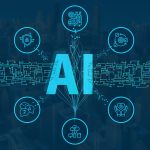Artificial Intelligence (AI) is transforming industries and reshaping the way we live and work. If you’re new to AI, you might have many questions about what it is, how it works, and its impact. Below are 10 common questions about AI, answered to help you better understand this exciting field.
1. What is Artificial Intelligence?
Artificial Intelligence (AI) refers to the simulation of human intelligence by machines, especially computer systems. It includes tasks such as learning, reasoning, problem-solving, and understanding language. AI can be found in technologies like voice assistants, self-driving cars, and recommendation algorithms.
2. What are the types of AI?
There are three main types of AI:
- Narrow AI (Weak AI): This type is designed to perform a narrow task, such as facial recognition or internet searches. Most AI applications today are narrow AI.
- General AI (Strong AI): This refers to AI that can perform any intellectual task that a human can do. It doesn’t exist yet but remains a goal for future research.
- Super AI: Hypothetical AI that surpasses human intelligence in all aspects. It is a subject of science fiction and theoretical research.
3. Which algorithm is commonly used for classification in AI?
Decision Trees are commonly used for classification tasks. They work by breaking down a dataset into smaller subsets while at the same time developing a decision tree to model the classification process. Other classification algorithms include Support Vector Machines and K-Nearest Neighbors.
4. What does NLP stand for?
NLP stands for Natural Language Processing, a branch of AI that focuses on enabling machines to understand, interpret, and respond to human language. Applications of NLP include chatbots, translation services, and sentiment analysis.
5. Which programming language is most commonly used in AI?
Python is the most commonly used programming language in AI. Its simplicity, wide range of libraries (such as TensorFlow, PyTorch, and Scikit-learn), and strong community support make it ideal for AI and machine learning development. Other languages used in AI include R, Java, and C++.
6. What is Machine Learning?
Machine Learning (ML) is a subset of AI focused on creating algorithms that allow computers to learn from data and improve over time. Instead of being explicitly programmed for every task, a machine learning system can identify patterns and make decisions with minimal human intervention.
7. Who is considered the father of AI?
John McCarthy is considered the father of AI. He coined the term “Artificial Intelligence” in 1956 and was a key figure in AI research. He also developed the programming language LISP, which became a standard in AI development for years.
8. What is a neural network?
A neural network is a system of algorithms that attempts to recognize underlying relationships in a dataset by mimicking the way the human brain operates. Neural networks are used in machine learning to identify patterns, classify data, and make predictions. They are the foundation of deep learning.
9. What is supervised learning?
Supervised learning is a type of machine learning where the model is trained on a labeled dataset. This means that for every input in the training data, the correct output is already known. The algorithm uses this information to learn and make predictions on new, unseen data. Examples include email spam filtering and image recognition.
10. What does CNN stand for in AI?
CNN stands for Convolutional Neural Network. It is a class of deep neural networks most commonly used for analyzing visual data, such as image and video recognition. CNNs are known for their efficiency in processing image data through layers that detect edges, shapes, and textures.


